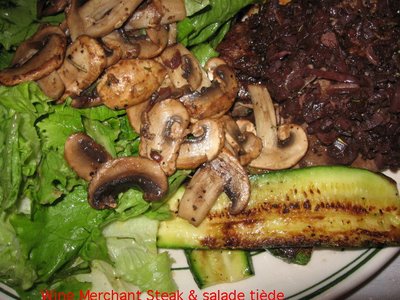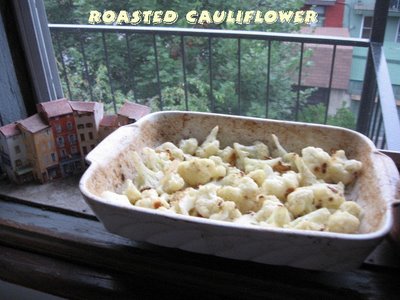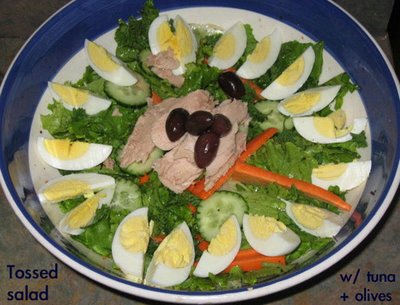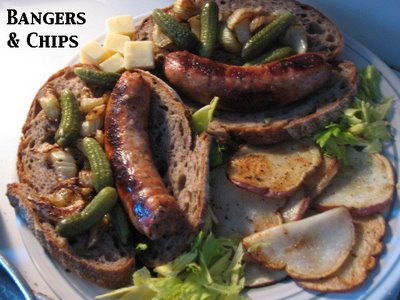20060731
20060726
It's the food, stupid
...or so I have to keep telling myself Papers papers everywhere... I knew that conducting my first formal tasting note would be an idea I'd like to try from the moment it was first suggested back in May by my favourite wine wizard Steve De Long on his site.
Papers papers everywhere... I knew that conducting my first formal tasting note would be an idea I'd like to try from the moment it was first suggested back in May by my favourite wine wizard Steve De Long on his site.
Sure, I've “tasted” wine before – I started this blog based on the tasting notes I was taking. (Although lately those notes have been few – summer seems to be having an effect on me.) But I've never really taken tasting notes in a standardized and systematic way. And what I've also never had is a wine education. Not really.
I'm a wine enthusiast not an expert. I grew up around wineries where several members of my immediate family found regular employment. I can remember taking part in educational tastings and tours, celebrating my 21st birthday among vats in the cellar, and more recently attending food and wine matching seminars. I'm keen on it all but it does not an expert make. More practice and discipline are required for that. Focusing on a proper tasting note is a good start for me, or so I thought.
And now this week, weeks after Steve introduced his downloadable tasting note, I finally set out. I was spurred on by the realization that my use of the term "astringence" is anything but expert. I’ve used it incorrectly in several posts over the last year, but I should make that the subject of another piece another time.
So I uncorked the Belleruche rouge for which Steve supplies his notes and went away to work. (He has done notes for various wines and suggests that if you can find the wine he's tasted, it's worthwhile to follow along on his while you complete yours.) The whole thing was a great success. Well, almost the whole thing. Here's how it went:
I would write down my note, then uncover what Steve noted, and then taste again to reconsider. I was pretty much with him all the way (his medium-heavy is what I've been calling medium; I have difficulty timing length of finish, as he says it is tough for anyone unfamiliar with this measurement; I have trouble separating the ideas of "level" and "hardness" of tannins). I even confidently added a flavour note as outlandish as cream soda, which doesn't quite make it onto the official flavour wheel, pehaps because you could parse it down to vanilla plus some combination of berries that approximates grenadine. So yeah, I was really feeling it. I ended up totally enjoying this wine, which I had had many times before, never liking it nearly this much. It was fabulous. Tasting session complete. Except the part of the form that Steve had left blank: food pairings. I was about to have dinner so I dove right in on this one. But the wine was unwilling. Suddenly its heady level of alcohol came screeching out. It seemed to lose its finesse at the dinner table, though my pairing of intensely flavoured veal, seared with sun-dried tomato and olive pasta was fairly well thought out for the occasion. I tried it again with dinner the next night, but nothing in the wine clicked with food like it did on its own during the tasting. And this was very disheartening but not surprising. I shy away from a lot of Rhône wines precisely because of this. Whether they are too alcoholic or don't have enough acidity to compete with the food I most often make, I can't say.
Tasting session complete. Except the part of the form that Steve had left blank: food pairings. I was about to have dinner so I dove right in on this one. But the wine was unwilling. Suddenly its heady level of alcohol came screeching out. It seemed to lose its finesse at the dinner table, though my pairing of intensely flavoured veal, seared with sun-dried tomato and olive pasta was fairly well thought out for the occasion. I tried it again with dinner the next night, but nothing in the wine clicked with food like it did on its own during the tasting. And this was very disheartening but not surprising. I shy away from a lot of Rhône wines precisely because of this. Whether they are too alcoholic or don't have enough acidity to compete with the food I most often make, I can't say.
But what is important to say, and Steve mentions this, is that you got to get food into the tasting process. He says it keeps things on track and centred. I simply say it is the very reason I open up a bottle most nights. So while the experience was an eye-opener, I don't expect to do many more proper tasting notes which start in isolation and then bring on the food if at all. The tasting notes on Weingolb will continue to be rooted in the dining experience, with a focus on food pairings.
Posted by Marcus | Wednesday, July 26, 2006 2 comments
20060725
20060724
Before you decant, deep-sea dive
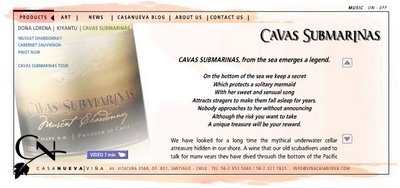
I don't know quite what to think now.
When I heard about wine anarchists cellaring wine at the bottom of a frozen lake, I first imagined the move as state-of-the-art, then as a fanciful prank. In the end, I think it was a sincere gesture made by wine lovers who don't like being hemmed in by the often constrainingly conservative world of wine.
News out of Saint-Malo, France indicates that the ocean-cellaring of wine is branching out in new directions. This Agence France-Presse newspaper article published last month suggests the unusual deep-sea storage of wine is getting serious attention from the more traditional wine establishment.
And that means you know the marketers can't be far behind. Click on the image above for the seductive offerings of Vina Casanueva, whose Cava Submarinas line of international varietals is not packaged in cases of twelve but laid out willy-nilly in barnacle-encrusted treasure chests. It's in this way that Cava Submarinas better gives wine adventurers "a legend emerging from the bottom of the sea". For their latest campaign, the winery also is kind enough to suit you up with goggles and an oxygen tank: access to this submerged cellar suddenly becomes self-serve.
If you're a pirate, that's probably how you'd want it anyway. Blackbeard will really get off on the video shown on the Casanueva site. Check it out, matey.
July marks the end of the birthday season among my closest circle of friends and this year we were really treated to some of the finest food BYOW Montreal has to offer. Our last stop was Restaurant Christophe, perhaps the nicest place in the city to bring out your favourite bottles for uncorking. We drank Domaine du Silène des Peyrals, among others. The way the food, the service, and the dining room ambiance came together, it was a real transportive experience. Like stumbling upon the most perfect Paris bistro.
If we once again put off the deep-sea diving during our next round of birthdays, we would surely call Christophe. Or even sooner than the next round of fêtes. They re-open after the Construction Holidays end on Sunday.
Posted by Marcus | Monday, July 24, 2006 4 comments
20060722
20060721
Make sure you deserve this dessert wine: Carlo Pellegrino Moscato
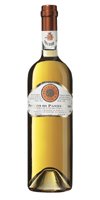
Well worth noting is how uniquely made this dessert wine is. You're sure to be roused after the very first sip of the stuff, which is called Carlo Pellegrino Passito di Pantelleria, so take a moment and consider this. It's produced by drying out and then vinifying Sicily's Zibibbo brand of Muscat grape (it turns out that there are many, many different varieties of Muscats, which surprised me). The Oxford Companion to Wine describes Moscato Passito-di-Pantelleria, a DOC appellation, as Italy's finest dessert wine -- lush, rich and more in the true dessert style than the less reputable, generic label simply called Moscato di Pantelleria ("passito" is the Italian term for dried grape wines).
The Oxford Companion to Wine describes Moscato Passito-di-Pantelleria, a DOC appellation, as Italy's finest dessert wine -- lush, rich and more in the true dessert style than the less reputable, generic label simply called Moscato di Pantelleria ("passito" is the Italian term for dried grape wines).
The book goes on: "...Passito di Pantelleria must have at least 14 per cent alcohol and 110 g/l residual sugar, although a current trend is to seek a more decadently sweet style, raisining the grapes for up to 30 days and arriving at close to 140 g/l of residual sugar."
Aside from the special care, this Moscato also has behind it a fanciful legend from antiquity. This Italian wine file talks about Passito di Pantelleria's divinity and its relationship to ambrosia.
I drank my Moscato with friends, which is a good idea since it is both too decadent and too deceptively alcoholic for the solo drinker. The dining room attached to my kitchen seemed to render itself a swanky drawing room in the presence of this wine's golden hues and storied history. The transformation commanded the attention of my camera lens.
TASTING NOTES FROM THE PANTELLERIA CHAIR
This wine has the delicious scent of orange blossoms. It is viscous and full on the palate with strong notes of apricot and tangerine and hints of cardamom. Drinking this moscato offers neat mouth-coating feeling, which is quite pleasurable. But it's not too syrupy either: a lightly bracing acidity makes the wine a refreshing expression.
And when served with anything as simple as a bit of chocolate, this wine makes for an exotic and fruity complement to the end of your meal.
Pantelleria, Sicilia, Italia. 15.5%
Posted by Marcus | Friday, July 21, 2006 0 comments
20060720
20060718
A dinner in Balconville
 The current wave of high heat and humidity peaked yesterday in Montreal. When it gets so insufferably hot, I require new strategies to continue to eat and drink in a civilized manner.
The current wave of high heat and humidity peaked yesterday in Montreal. When it gets so insufferably hot, I require new strategies to continue to eat and drink in a civilized manner.
Plan B is always flee to an air-conditioned restaurant, but since I am currently paying for two balconies which by the grace of God are shaded from the sun, dining outside where you can catch an occasional breeze is the best plan of attack. (Especially during those prolonged heat waves when night after night of eating out is not financially viable.)
So as a result, I have practically perfected the following tricks.
I hope they work as well for you as they have for me.
HOW TO COOK AND EAT WELL IN THE SUMMERTIME HEAT
- Follow the forecasts: This is not to strike fear in your heart but to find the silver lining. Forecasts may feature temperatures well into the 30s, but every forecasted high has its low. Even if a forecasted low only dips down to the mid twenties, chances are it's going to happen in moments after dawn, when the air temperature routinely dips due to some scientific phenomenon that I can't explain. But knowledge and wisdom are two separate things so it is the wise cook who heads into the kitchen early. Be like the baker. Sanely turn on the oven when your kitchen doesn't already feel like one. (Yes, this means that dinner will be ready a bit early than usual but you don't have to eat it hot out of the kitchen, which brings me step 2...)
- Prepare cold dishes: This is a no-brainer. Not only does no one want to eat hot food during a heatwave, cold dinners are part and parcel of cooking ahead. So refrigerate your dinner. Let it cool on the counter for about half an hour and then wrap it up for cold storage. Some food works better than others chilled but you can't go wrong when all you want is a meal that helps to cool you down. I made this bean mash recipe, and a dish called Aubergine Continental, and marinated grilled chicken (just throw on the oil, mustard powder, dried onion, red pepper flakes, soy sauce, and whatever else for however long you want -- I don't subscribe to the idea of a perfect marinade -- and then slap it on the stove). Just before we sat down I served it all on local lettuce leaves, making the prepared meals look even fresher and more appetizing.
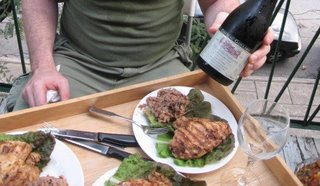 Place chillable reds in the freezer: This step is even easier when you have savvy guests like Gordon, who always show up with just the right chillable selection. Though my prepared dinners were from the southern French school of cooking, and despite the fact that a light and spicy Rhône red is always a good candidate for chilling, we ended up opening a Loire red called Château Gaillard (Touraine-Mesland 2004) -- you can click on the image for more on currently available vintages -- and then followed it with the Dominio del Arenal Utiel-Requena 2005, a red from western Spain whose D.O. (Denomination of Origin) takes its name from regional towns located near Valencia. It had equally elegant fruit as the Touraine-Mesland did and joined in perfectly mid-way through dinner. Perhaps at first it was a bit cold from its time in the freezer but on this particular day it got up to a suitable 16 degrees before you could finish your first glass.
Place chillable reds in the freezer: This step is even easier when you have savvy guests like Gordon, who always show up with just the right chillable selection. Though my prepared dinners were from the southern French school of cooking, and despite the fact that a light and spicy Rhône red is always a good candidate for chilling, we ended up opening a Loire red called Château Gaillard (Touraine-Mesland 2004) -- you can click on the image for more on currently available vintages -- and then followed it with the Dominio del Arenal Utiel-Requena 2005, a red from western Spain whose D.O. (Denomination of Origin) takes its name from regional towns located near Valencia. It had equally elegant fruit as the Touraine-Mesland did and joined in perfectly mid-way through dinner. Perhaps at first it was a bit cold from its time in the freezer but on this particular day it got up to a suitable 16 degrees before you could finish your first glass.
Posted by Marcus | Tuesday, July 18, 2006 3 comments
20060713
Vin de pays: A country's worth of wine
 On the weekend I took my friend Jane shopping for wine. I love shopping for wine and Jane wanted to take advantage of a "save on six" sale at the liquor store. She ended up getting 12 bottles so the extra hands helped in carrying the wine home.
On the weekend I took my friend Jane shopping for wine. I love shopping for wine and Jane wanted to take advantage of a "save on six" sale at the liquor store. She ended up getting 12 bottles so the extra hands helped in carrying the wine home.
When we got there with her haul I had to snap a few pictures. Without planning it, we had collected a case worth of French vin de pays, four of which were the outstanding 2004 Domaine de Gournier Vin de pays des Cévennes, a red blend. These "country wines" are mostly produced within the Midi and are very affordable (Jane's total bill translated to $9 CDN per bottle). But they also represent a gamut of different varietals as well as blended varietals. Merlot, Cabernet, Syrah, Grenache, Sauvignon, Chardonnay, Marsanne, and that's without beginning to mention those grape varieties that aren't international. It's no wonder we picked up so many vin de pays.
Today it's Jane's birthday so we will be enjoying some special wine and dining out at a BYOW resaurant. We likely won't be opening any of the bottles we bought, but that's okay. French country wine may be more simple than special. They still seem to elevate your everyday midweek dinner like no other.
So stylish and so affordable are these wines that we should've warned Jane's friendly neighbourhood bon vivant to pace himself:
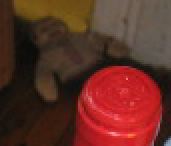
Happy birthday Jane! Hope you are not too too much of a bon vivant tonight.
Posted by Marcus | Thursday, July 13, 2006 1 comments
20060712
Yellow Tail yellowtail [yellow tail]
Please don't buy this wine.
I was doing a little research on the web traffic of various wine blogs. A lot of my peers permit free access to their hit counters and I was surprised to see how many web surfers are referred to wine pages based on a search of "Yellow Tail".
Well, hopefully some of those inquisitive minds will start getting directed here. Please stop and read this! Yellow Tail wines are unsavoury mass-produced products. I haven't tried them all but each vintage is over-oaked and sweet. Avoid purchasing them.
THIS SURGEON'S GENERAL WARNING
The sweetness of these wines is the most troublesome aspect. Because Yellow Tail is a wine that uninitiated wine drinkers gravitate to (whether because of mega marketing campaigns or sheer worldwide over-distribution), those that are new to the world of wine are off to a bad start. The problem is that when you come to expect something that tastes so syrupy and sweet, you start finding that drier, more traditionally styled wines get lost on you. And so you buy more Yellow Tail like it's Coca-Cola. The downward spiral begins.
And since the New World is already creating a challenge for more traditional Old World wines, Yellow Tail is a particularly dangerous trend setter. I urge wine drinkers, especially those fresh-faced and curious ones, to try any of the links shown down the sidebar at left for interesting alternatives to that easy-to-find, easy-to-gulp, but hard-to-respect Yellow Tail.
Thank you.
Posted by Marcus | Wednesday, July 12, 2006 6 comments
20060711
20060710
"Chianti!" "Bordeaux!" Why not put Swiss wine in your World Cup? Testuz Chasselas du Pays Romand 2003
 - "Viva Italia!"
- "Viva Italia!"
- "Allez les Bleus!"
- "Numero uno!"
- "Premier au monde!"
- "Anchovy pizza!"
- "Foie gras pâté!"
On a weekend when everyone had to pick sides and honk for either Italy or France, I opted for traditional Swiss neutrality. I shut myself in, turned the TV off and had myself a rather large but inoffensive salad.
Then I poured myself some Chasselas, a variety of white wine from Switzerland, which happens to the homeland of reigning Wimbledon champion Roger Federer. This is the first time I've had a real Swiss wine. I relished the subversiveness of all: walking down the empty streets to a totally vacant liquor commission (save for a few miffed employees who from time to time would peer across the block to the jammed-pack sports bar for a sign as to which team was winning the World Cup), picking out a peculiar Swiss bottle and doubling back for home. The purchase was so stealthy, so quick and without any hesitation whatsoever, it reminded me of a superbly struck Federer backhand.
Say, didn't he just win that title again for like the FOURTH CONSECUTIVE TIME? Yes, he did. In fact, it was probably between televised head butts and penalty kicks that Champ Roger joined Amélie Mauresmo, the newly crowned women's winner, to celebrate their weekend hauls at the Wimbledon Champions' Dinner at the Savoy Hotel in London. Amélie was likely stressed that her French football team couldn't rise above the situation to win the match like she had done on the court against the wiles of Justine Hénin-Hardenne just one day earlier. I'm sure if she had some lovely wine like the Testuz Chasselas du Pays Romand in reach she'd enjoy it nonetheless. She earned that and much more with a solid and well-constructed victory.
Amélie was likely stressed that her French football team couldn't rise above the situation to win the match like she had done on the court against the wiles of Justine Hénin-Hardenne just one day earlier. I'm sure if she had some lovely wine like the Testuz Chasselas du Pays Romand in reach she'd enjoy it nonetheless. She earned that and much more with a solid and well-constructed victory.
I should be perfectly clear about Amélie being something of a connoisseur of fine wines. While anyone can tell you a Swiss vin de pays is quite different than an well-aged Bordeaux, it is important to realize that this women's world No. 1 is so congenial, pleasant and easy to get along with that you'd have no inkling of doubt she'd join Roger in a glass of his local Chasselas and a chaser, or two, regardless of World Cup results or the calibre of this provincial wine.
Here's what I know about this Chasselas varietal:
FOR FEDERER AND THIS GRAPE, NEVER BETTER TIME TO BE NEUTRAL Chasselas is the white grape of Switzerland, especially the French-speaking western regions of Valais, Vaud and Geneva, where it makes up the vast majority of grape yields. Like its homeland, Chasselas is known as a neutral grape and interesting only when in the hands of reputable vintners who can use it to coax out aromatic characteristics of the terroir. Hugh Johnson writes that the Chasselas of Valais is typically racy or exotic; Vaud's is refined and full; and Geneva's is simply elegant.
Chasselas is the white grape of Switzerland, especially the French-speaking western regions of Valais, Vaud and Geneva, where it makes up the vast majority of grape yields. Like its homeland, Chasselas is known as a neutral grape and interesting only when in the hands of reputable vintners who can use it to coax out aromatic characteristics of the terroir. Hugh Johnson writes that the Chasselas of Valais is typically racy or exotic; Vaud's is refined and full; and Geneva's is simply elegant. My purchase wasn't a direct mapping to any of the above, though Valais is perhaps the best fit in retrospect. Overall, I would label Testuz Chasselas du Pays Romand 2003 flinty and slightly fizzy (which supposedly is a trait of northern Neuchatel's Chasselas). But if trademark characteristics don't come through it is likely due to the fact that this Chasselas du Pays Romand is a vin de pays and as such sidesteps around the three big appellations of these French cantons.
My purchase wasn't a direct mapping to any of the above, though Valais is perhaps the best fit in retrospect. Overall, I would label Testuz Chasselas du Pays Romand 2003 flinty and slightly fizzy (which supposedly is a trait of northern Neuchatel's Chasselas). But if trademark characteristics don't come through it is likely due to the fact that this Chasselas du Pays Romand is a vin de pays and as such sidesteps around the three big appellations of these French cantons.
It has a light straw colour. Acceptably bracing acidity and good mouthfeel, this Testuz wine is light and refreshing on the palate. Exceptionally mineral-y with hint of butterscotch towards the finish.
An aftertaste like that was a nice segue into my dessert, which of course was Swiss Almond ice cream. Delicious and potentially churned from Roger's very own Swiss cow!
Jean et Pierre Testuz, Treytorrens en Dézaley, Schweiz (Switzerland). 12%.
Posted by Marcus | Monday, July 10, 2006 3 comments
20060708
20060705
WBW #23 Bottles for the Barbecue: La Baume Selection 2001

My barbecue isn't exactly the real thing but...
La Baume Selection Shiraz Cabernet...
...makes poser barbecue food entirely authentic!
At first all I could do was turn on the stove and follow a meagre strand of smoke as it trailed into the air. The only hint of real BBQ flavour I could hope for, coming up from yesterday's oil splatter still clinging to the electric element.
And so WBW #23 begins humbly, but a not-so-modest bottle stands in my corner.
The 2001 Selection Shiraz Cabernet from Domaine de la Baume pours out of its bottle (which has a nifty panoramic wrap-around wine label) in blackened reddish purple stream. A bit like black cherry syrup or perhaps blood -- c'mon it's a barbecue theme, let's celebrate the joys of meat!
This wine exalted my faux barbecue from the moment I uncorked it. Its feral volatile nose -- mustardy and at the same time funky smelling too -- was wild and unrestrained.
To finally taste it, La Baume Selection Shiraz Cabernet 2001 is not complex but assertive with great depth on the palate. It's a full-bodied spicebox kind of wine with nice tannic edges that are not too sharp but still manage to give off a generous amount of supple vanilla-loaded oak. Kind of sweet and very reminiscent of a big Aussie style of wine. Which makes sense: it's no coincidence that this Vin de Pays D'Oc hides its provenance on the back label and uses mostly English on the bottle. Domaine de la Baume is an a now-expired operation that was run by Australians transplanted to Southern France. Since 2001 was a landmark year for Languedoc, I'm happy to have had at least this lone bottle from these stylish vintners, the Hardys from Down Under.
On the second night, this La Baume (most likely a French name chosen based on its similarity in pronunciation to "The Bomb") opened up more to reveal even more fruit. Great and rich fruity flavours -- blueberry mostly and cassis. Like many wine of its style, it is a tad high in alcohol but it doesn't taste too, too hot and whatever heat it gives off you are rewarded for by pairing it with barbecue food. This wine is built to stand up to smoky, spicy and meaty meals. In general this wine is nice to have around food.
In addition to my rib-eye, grilled zucchini and taters, this Shiraz-Cabernet blend also hit it off with sundried tomato and basil sausages. Such is the beauty of the flexible and BBQ-friendly Cabernet-Syrah mixture. Good times. Thanks to Vivi's Wine Journal for the open invitation.
Servian, France. 14.5%
Posted by Marcus | Wednesday, July 05, 2006 2 comments




